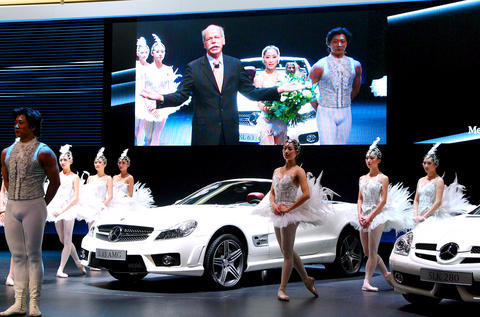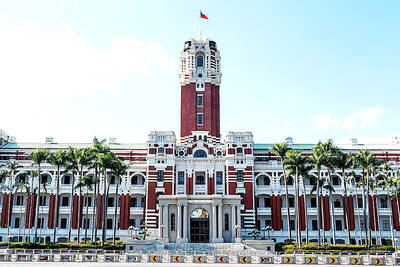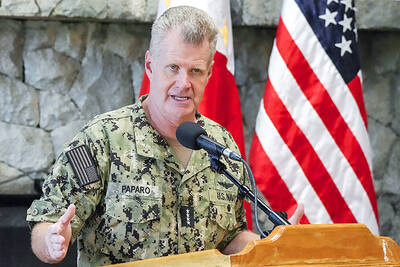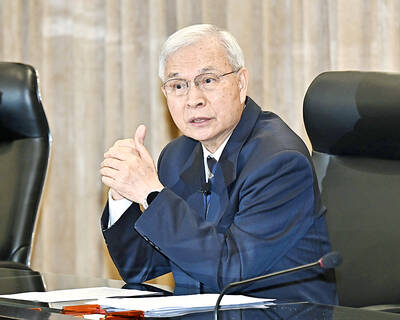General Motors Corp (GM) and Daimler AG unveiled plans on Tuesday for lithium-ion hybrids as automakers push to overcome difficulties with a technology that promises to push hybrid autos to the next level of performance.
Daimler AG will be the first to get to market, announcing plans to introduce a hybrid version of its Mercedes-Benz flagship S-class luxury sedan using a gasoline engine and a lithium-ion power source next year.
The new S-class is what is called a "mild" hybrid, meaning the electric motor aids combustion but does not itself drive the car, instead boosting the main engine. The new models will achieve a carbon dioxide emissions level of 190 grams per kilometer, higher than many small cars with efficient engines but which Daimler strategist Johannes Reifenrath said would make it the most efficient luxury car in the world.

PHOTO: EPA
To date, the least-emitting car in Mercedes' fleet is the diesel S-class with 230g/km.
The Mercedes example demonstrates the application of the technology at the luxury end of the market and is driven in part by tougher regulations taking effect in Europe in 2012 that would require automakers to reduce average emissions in their fleet to 130g/km.
"Change has to start now. Automakers can't wait until 2012," Reifenrath said.
General Motors said it expects to bring its first lithium-ion battery powered hybrid engine system to market in North America sometime in 2010. No product has been announced yet, but officials said the technology had potential across a broad range of product models.
GM showcased the technology in a Saab concept car, boasting carbon emissions of 117g/km on gas and 105g/km on ethanol. Unlike GM's other hybrid project -- the Volt, which has a large battery that can move the car by itself -- the new concept uses a smaller battery about the size of a case of soft drinks to assist the main internal-combustion motor.
The dual announcements indicated increased confidence in the technology, already widely used in consumer electronics. But adapting to meet demanding auto requirements has been an obstacle as has concerns about costs and overheating.
"I think there's a trend there. I think it is good news that Mercedes and GM are coming out at the same time," GM spokesman Scott Fosgard said.
GM is working with Hitachi, which has used a lithium-ion battery in an electric car, to develop its technology. GM's chief hybrid engineer, Stephen Poulos, said that the Hitachi battery design would give the GM application a degree of stability because it was easy to regulate the flow of energy -- but that tests were still being done to ensure stability to prevent overheating and the potential for fires.
"There are a lot of controls to make sure that doesn't happen," he said. "It is a more forgiving application of the lithium ion than most applications out there."
Because they are smaller yet more powerful than the nickel metal hydride batteries used in first-generation hybrid cars, like Toyota Motor Corp's Prius, lithium-ion technology holds the potential to be used across a wider range of models -- as Mercedes' launch of the technology in its powerful S class indicates.
GM chief executive officer Rick Wagoner said the company expected the technology to improve fuel economy by 20 percent. But he said to have a real impact, the technology must drive high volumes.
"The view is that the technology has the opportunity to get a much better range on a small battery and this has a chance to break through in a big way," Wagoner said.
GM said it expects hybrid sales volumes to exceed 100,000 vehicles per year. The system would build on GM's current hybrids, reducing engineering costs and the cost to consumers, the company said.
The battery system would be mated to a wide range of GM engines, including turbocharged gasoline, diesel and bio-fuel power plants. GM said in a statement that the new hybrid system would save fuel by turning the engine off at idle and cutting off fuel during deceleration. It would offer brief electric-only power, the company said in a statement.

The CIA has a message for Chinese government officials worried about their place in Chinese President Xi Jinping’s (習近平) government: Come work with us. The agency released two Mandarin-language videos on social media on Thursday inviting disgruntled officials to contact the CIA. The recruitment videos posted on YouTube and X racked up more than 5 million views combined in their first day. The outreach comes as CIA Director John Ratcliffe has vowed to boost the agency’s use of intelligence from human sources and its focus on China, which has recently targeted US officials with its own espionage operations. The videos are “aimed at

STEADFAST FRIEND: The bills encourage increased Taiwan-US engagement and address China’s distortion of UN Resolution 2758 to isolate Taiwan internationally The Presidential Office yesterday thanked the US House of Representatives for unanimously passing two Taiwan-related bills highlighting its solid support for Taiwan’s democracy and global participation, and for deepening bilateral relations. One of the bills, the Taiwan Assurance Implementation Act, requires the US Department of State to periodically review its guidelines for engagement with Taiwan, and report to the US Congress on the guidelines and plans to lift self-imposed limitations on US-Taiwan engagement. The other bill is the Taiwan International Solidarity Act, which clarifies that UN Resolution 2758 does not address the issue of the representation of Taiwan or its people in

US Indo-Pacific Commander Admiral Samuel Paparo on Friday expressed concern over the rate at which China is diversifying its military exercises, the Financial Times (FT) reported on Saturday. “The rates of change on the depth and breadth of their exercises is the one non-linear effect that I’ve seen in the last year that wakes me up at night or keeps me up at night,” Paparo was quoted by FT as saying while attending the annual Sedona Forum at the McCain Institute in Arizona. Paparo also expressed concern over the speed with which China was expanding its military. While the US

SHIFT: Taiwan’s better-than-expected first-quarter GDP and signs of weakness in the US have driven global capital back to emerging markets, the central bank head said The central bank yesterday blamed market speculation for the steep rise in the local currency, and urged exporters and financial institutions to stay calm and stop panic sell-offs to avoid hurting their own profitability. The nation’s top monetary policymaker said that it would step in, if necessary, to maintain order and stability in the foreign exchange market. The remarks came as the NT dollar yesterday closed up NT$0.919 to NT$30.145 against the US dollar in Taipei trading, after rising as high as NT$29.59 in intraday trading. The local currency has surged 5.85 percent against the greenback over the past two sessions, central